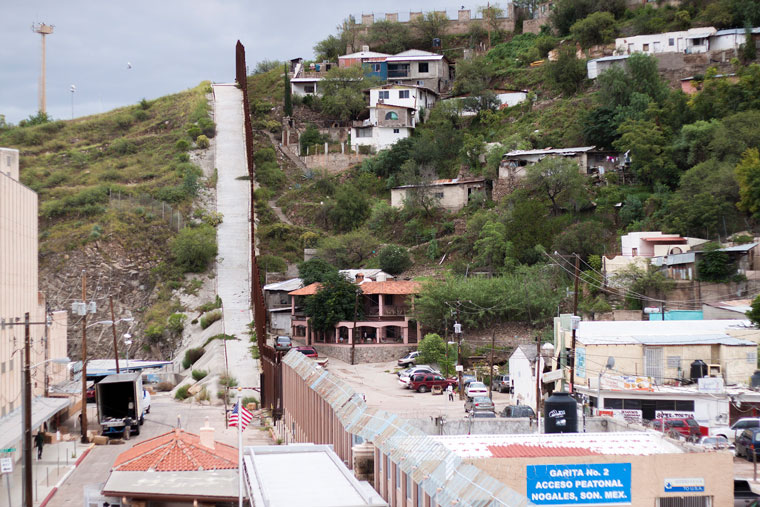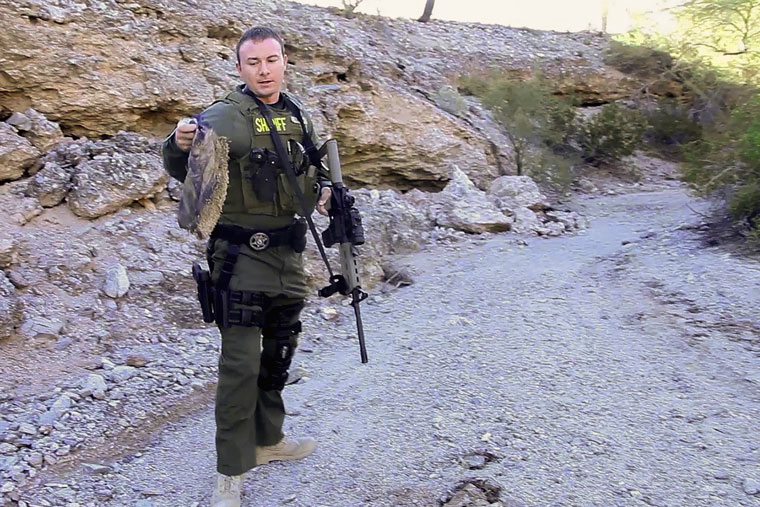Researchers and law enforcement officials say that a majority of the drugs that enter the U.S. from Mexico are smuggled by vehicle. But these days informants are telling Platt and other sheriff’s detectives that cartels have started concealing small packages of heroin within larger bundles of marijuana that are backpacked from the border. It’s another example of the constantly changing nature of the drug trade.
“We know they’re going to make changes,” Platt said. “Especially the more we get or the more our counterparts get, they’re going to change it up. We know that’s going to happen. All we can do is just try to get the intel we can on what they’re doing and try to adapt to it.”
Coleman, the DEA special agent, said agents have to change their methods regularly to keep up with the cartels.
“Law enforcement never stops any crime,” he said. “Our job is to investigate, arrest, prosecute and bring to justice those that violate the law.”
In Pinal County, drug traffickers sometimes will call 911 to report a fake emergency to divert law enforcement agencies from a route where they intend to smuggle drugs. But Platt knows what to look for: Is the caller making sense? Providing his or her name? Able to provide details about the incident?
If the caller doesn’t offer those details, Platt goes on high alert. While other deputies respond to the report, he may stick back and look for any suspicious behavior.
It’s situations like these that require Platt and other detectives on the Anti-Smuggling Unit to think on their feet and continually evolve.
Platt said there will never be a way to end heroin trafficking. But he said harsher punishments for users and traffickers could cut it down.
“As long as there’s a demand, it’s not going to stop,” he said. “The only thing we can do is try our best and try to keep the numbers down. That’s it.”
A little ways northwest of Interstate 8, Platt, carrying a rifle, climbed over a barbed-wire fence, clambered up a dirt hill and went into a wash.
Walking through this same area eight months ago, leftovers from smugglers were everywhere. Gallon-size water bottles, carpet shoes designed to conceal shoe prints and leftover burlap used to wrap narcotics littered the curving wash for about a quarter of a mile.
Some scraps remained, but it was mostly cleaned out.
“They’ve changed it up,” he said. “They’re using somewhere else.”
A national plague
Just up the road from Pinal County, in a secluded building in north Phoenix, yet another law enforcement agency works to stop the trafficking of heroin into Arizona and onto the rest of of the United States.
While most other law enforcement agencies are responsible for intercepting drugs traveling through Arizona, the FBI’s Phoenix Bureau is responsible for dismantling the cartels.
“We don’t focus on the drug itself,” said Ronald Baker, a supervisory special agent at the FBI. “We know the issues behind it. Our focus is on these transnational criminal organizations that manufacture, distribute and sell these kind of drugs.”
Baker supervises the FBI squad tasked with investigating criminal groups, conducting joint operations with other agencies and ultimately dismantling cartels. With FBI Director James Comey describing heroin as a plague in the U.S., stopping criminal organizations responsible for moving it through Arizona is a priority.
But FBI agents run into the same problem as Ramirez and Platt: Because the drug trade is so lucrative, cartels are constantly changing tactics, and it’s hard to keep up.
“If there’s been success by a particular law enforcement organization that stops maybe how things have been brought in through a certain area or port, then those criminal organizations are going to find another way around,” Baker said.
The FBI uses a variety of techniques to track and break up drug trafficking organizations. Agents will conduct wiretaps, work on interagency investigations and focus on dismantling smaller satellite groups.
“That affects the bigger group, the transnational organized crime group organization out of Mexico and other parts of the world,” Baker said.
Bruce Bagley, a professor at the University of Miami who has written about drug trafficking trends extensively, said law enforcement agencies will use every trick in the book to dismantle an organization. That includes squeezing informants, conducting electronic interdiction, wiretapping phones, following cellphones, patrolling airspace and tracking Internet use.
Because of drug trafficking organizations’ willingness to do absolutely anything to get narcotics into the United States, Bagley estimates that law enforcement agencies only stop 15 percent of the drugs brought into the U.S.
“The illicit profits are so high that they drive innovation, whereas the rewards that are received by law enforcement remain constant whether they increase or decrease their annual count or seizure numbers,” he said. “They’re simply not compensated in the same way. They work 9 to 5 or 8 to 5. The traffickers work 24 hours a day.”
Bagley said it’s important to focus on law enforcement and halting the flow of heroin but contends that resources would be better used to curb demand and for treatment and rehabilitation. He said the government should focus on vocational training, education, getting people to finish their high school degrees and ending jail time for nonviolent drug-related crimes.
“I have argued for a long time that much of this money is basically wasted,” Bagley said.
But Pietshcmann, with the U.N. Office on Drugs and Crime, said law enforcement can be effective. He pointed to Australia’s effort to dismantle heroin rings in 2001.
“Heroin consumption declined by about 80 percent in Australia. And the people dying by opioids in Australia has declined by 60 percent. And this has not changed since,” he said. “Thirteen years, and the heroin market has not recovered in Australia.”
The FBI’s Baker said it’s tough to determine the best way to combat the drug trade, describing it as a business model that’s going to evolve with supply and demand.
“The transnational organized criminal groups look at ways to evolve, to change with what we’re doing to stop them,” he said. “There is a constant evolution in combating the drug problem.”



